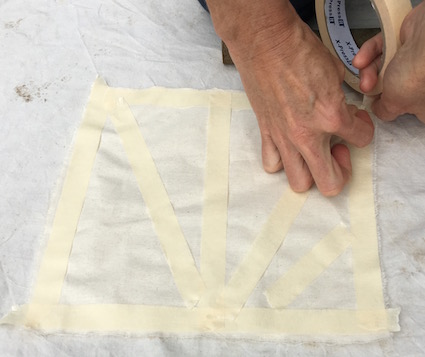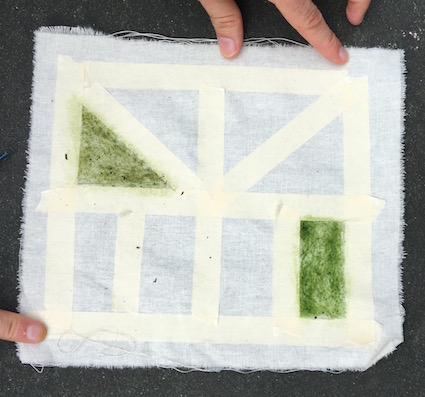
One activity that is consistently popular with children and adults is masking tape art. During a recent outdoor training session, I realised the concept fitted rather well with exploring aspects of 2D shape. Each child needs a piece of calico cotton or old sheet.
Begin by creating a masking tape border to create a large shape. Then challenge the children to create other shapes within this shape through adding strips of masking tape. Make sure the tape is pressed down well. At this point it can be good to have a chat about all the different shapes within the shape that have been created.

Once the masking tape shape frame has been created, children can rub pieces of leaves, berries, soil and other found natural materials into the frame. It’s a fascinating thing to do. What colour arises on the cotton sheet from a found object is always a bit of a surprise. This is further compounded by the texture of the underlying surface. So rubbing the cotton with a leaf on a wall can look different when this happens on asphalt or a pavement slab.
When the design is completed, remove the masking tape and observe the effect. The used masking tape can be saved for a messy printing activity on another day.

The effect is always rather stunning. It also makes a great basis for chatting about properties of shape. At this point it can be useful to let children think and discuss this amongst themselves and see what ideas they come up with before adding additional questions such as:
- How many triangles have been created? Is it only possible to make right-angled triangles when undertaking this activity?
- Does anyone remember what a quadrilateral is? What examples of quadrilaterals have you created?
- Are there any congruent shapes? What does this mean?
- Which shapes show a family likeness? Can you remember what this means?
- What other properties of shapes are featured in your picture?
- Does your pattern remind you of anything? How could you use your picture now or what can you do with it?
- What would be an excellent mathematical description of your masking tape shape picture? If it’s easier, can you annotate your picture in some way?
As you have probably worked out, the level of the discussion, questions and expectations around the responses given can be pitched at different levels. So this activity works well for all ages and abilities. It’s also a useful technique for assessing children’s knowledge and understanding of 2D shapes and their properties.
If you go on Pinterest there’s lots of masking tape art suggestions. I just like the maths that emerges 🙂 Many thanks go to Lily Rowe-Horseman who told me to rub plants into the cotton instead of paint.






























Hi Juliet. I tried this to introduce Isosceles, scalene and equilateral triangles. The children loved it. They stuck masking tape to their rulers to measure the sides of the triangles accurately and then stuck it on to some fabric. They then went outside to rub grass, flowers, leaves or mud (basically anything they could find) to ‘colour in’ the triangles. They now have a good understanding of the differences as they really enjoyed the lesson. Thanks.
I have photographs if you’d like them but wasn’t able to attach them in this comment.
Hello Nikki
Thanks for your feedback and also sharing how you developed the lesson further – I always hope this is what people do… take the idea and make it even better 🙂